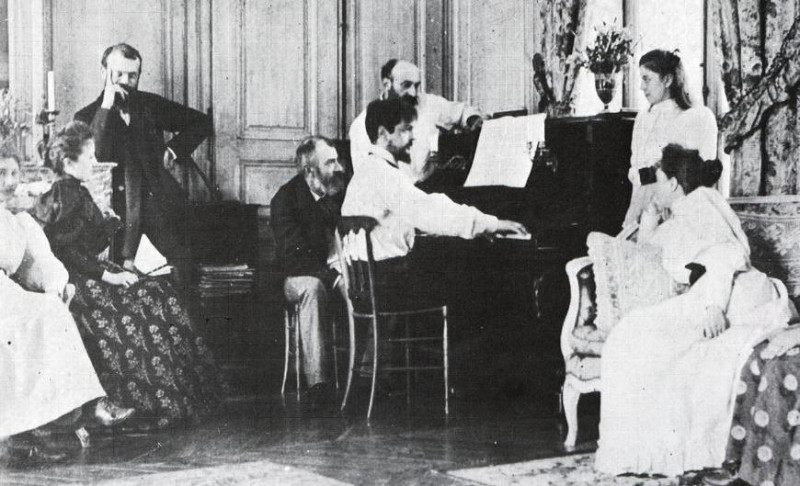Music meant for the ears
One hundred years ago on 25th March, the very day Claude Debussy passed away, Béla Bartók was celebrating his 37th birthday. A couple of weeks later the periodical ‘Esztendő’, owned by Lajos Hatvany, asked Bartók to assess the works of the French composer. He summed up his analysis thus: “The significance of Debussy is unquestionably revealed by the impact that he exercised – in the best possible meaning of the word – on the young generation of musicians, both abroad and in our own country. Whether this impact will prevail and evolve into further progress is impossible to predict. However, one thing is for sure, his compositions will not lose colour because he pooled great value in them.”
That is to say, Bartók differentiated between the artistic oeuvre and its impact, and while he was confident about the intrinsic value of the work, he was less convinced about its lasting effect on future generations. Only a few days after the release of Bartók’s review Kodály’s own obituary of Debussy was published in the April issue of Nyugat. It also divided his oeuvre and its effect. Yet Kodály took a diametrically opposite view to Bartók: ‘It is possible that Debussy’s music will for a long time or even forever remain marginal. It is possible that he has left behind less value than inspiration. Perhaps his didactic influence surpasses the oeuvre itself. His compass is showing the direction towards refined art of high order.’

Debussy on the piano in the salon of Ernest Chausson. Photo: Liszt Academy / Library
The opposing views offered by the two most outstanding Hungarian musicians of the early 20th century about the significance of Debussy, who undoubtedly exerted massive influence on both of them, reveal as much about Bartók and Kodály themselves as about the greatness of the French master. These days Debussy’s music enjoys more popularity than ever before. Deutsche Grammophon published twenty-two CDs and two DVDs covering his entire oeuvre on the occasion of the 100th anniversary of Debussy’s death, while great publishing rival Warner released thirty-three CDs containing an even more ‘complete’ oeuvre, adding reconstructions of fragmented compositions, juvenile works and transcripts, in fact, practically every note jotted down by the master.
In leaving behind compositions to ‘breathe’, Debussy’s power to influence remains substantial. While it was the mature Debussy of Pelléas that Bartók and Kodály regarded as their essential motivation, Debussy’s late works have provided a fountain of inspiration for younger generations. Pierre Boulez was spellbound by the collage-type drafting and constantly varying form of Jeux, the master’s last symphonic composition, a non-conforming music for ballet. In the case of György Ligeti, the composer’s last pieces for the piano, the piano études written in 1915, provided the direct stimulus for the composition of his own piano studies.
Debussy belongs to the category of late bloomers. Had his life reached its end at, say, the age of thirty-one, like Schubert’s, he would be merely regarded as a talented representative of his generation, one who in at least some of his songs displayed a unique gift for composition. Yet something phenomenal did take place around 1893 when Debussy reached his thirties. From around the time of his Prelude to the Afternoon of a Faun, which was inspired by one of Mallarmé’s poems, Debussy emerged with his very own voice, a tone never to be mistaken for anyone else’s. Traces of it had surely existed years before in his compositions but had until then remained unrecognised. This unique Debussy style was nourished by a number of sources. One such source is Javanese music, which he became acquainted with at the 1893 Paris World Fair. It provided him with the same inspiration as the discovery of Hungarian folk music did to Bartók and Kodály.
“Javanese music preserves such counterpoint,” enthused Debussy in one of his articles, “to which that of Palestrina compares like a naive child’s play. If we are listening unprejudiced to the grace of their percussions, we must admit that our own is no more than the barbarian pandemonium of some travelling circus.”
Another cornerstone in the building of Debussy’s style is the music of 19th-century Russia. The tonal parade of Rimsky-Korsakov’s orchestra taught him as much as the economic, refined and archaic-sounding music of Mussorgsky. “His compositions are made up of consecutive small stoke of the brush, which are bound together by some mysterious connection and the breathtaking competence of his insight,” claimed Debussy about Mussorgsky, although it can be argued that his own composition style also lives up to this statement. Moreover, there is a component in Debussy’s style of French Baroque music, which he rediscovered around the end of the 19th century. As well as having value in its own right, the music of Rameau and Couperin offered Debussy, in the same way as did the music of the Russian composers and Javanese gamelan, a route of escape from the fatal embrace of German composition. Like many of his young contemporaries, Debussy was initially enthusiastic about Wagnerian music. However, unlike the others, he subsequently became deeply disillusioned by it. His mature compositions do display traces of Wagnerian influence, yet he was struggling to combat this influence in most of his works. Even so, his music is not that of denial. It was precisely by wrestling the philosophically overburdened Wagnerian music that Debussy came across the primordial idea that perhaps best explains his enduring popularity – and one which many continue to forget even today – namely, as he claims in a report in 1909: “We are too busy writing music for the paper, yet music is meant for the ears.”
Gergely Fazekas


